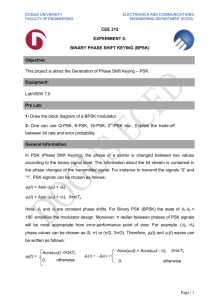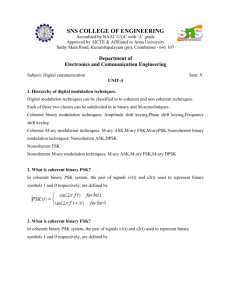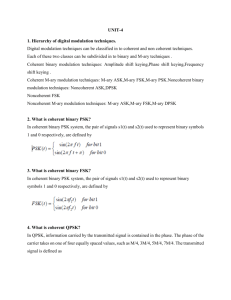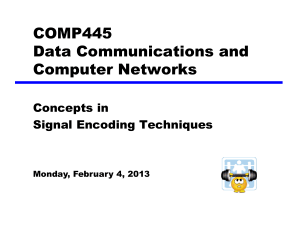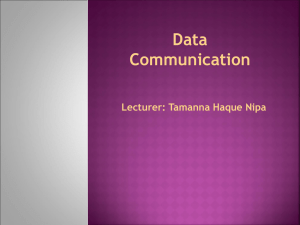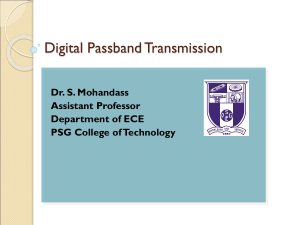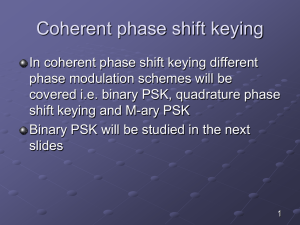(1) was received
advertisement
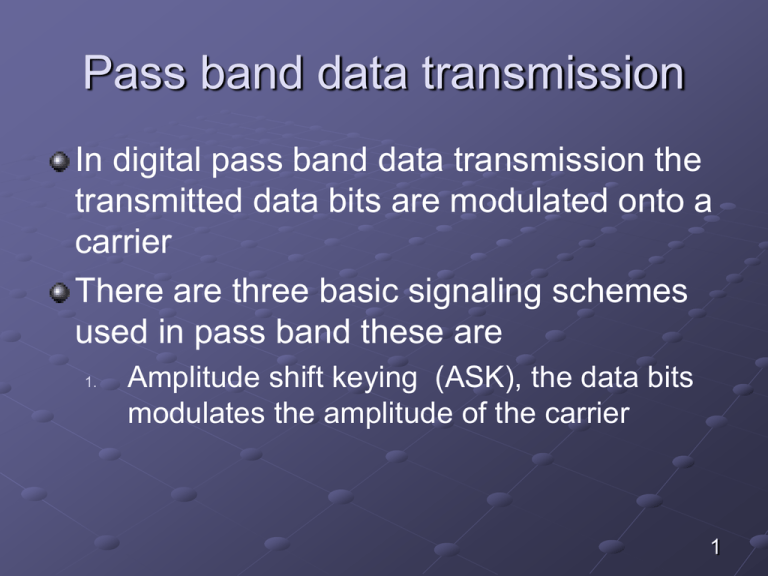
Pass band data transmission
In digital pass band data transmission the
transmitted data bits are modulated onto a
carrier
There are three basic signaling schemes
used in pass band these are
1.
Amplitude shift keying (ASK), the data bits
modulates the amplitude of the carrier
1
Pass band data transmission
2.
3.
Frequency shift keying (FSK), the data bits
modulates the frequency of the carrier
Phase shift keying (PSK), the data bits
modulates the phase of the carrier
Those three keying schemes are
illustrated graphically in next slide
2
Graphical representation of
ASK, FSK and PSK
ASK
PSK
FSK
3
Hierarchy of digital modulation
techniques
Digital modulation techniques can be
classifieds into
1.
Coherent
2.
Non coherent
This classification depends on whether the
receiver contains a phase recovery or not
4
Hierarchy of digital modulation
techniques
In general coherent detection has a better
immunity to noise but requires a
complicated circuit compared with non
coherent demodulation schemes
5
M-ary signaling schemes
In many applications where the channel
bandwidth is limited it is desired to transmit
more than one bit using a single carrier
Modulation schemes designed in this
manner are called M-ary signaling scheme
In pass band transmission these schemes
are known as M-ary ASK, M-ary FSK and
M-ary PSK
6
M-ary signaling schemes
It is possible to generate M-ary signals by
combining more than one modulation
scheme such as amplitude and phase shift
keying which is know as APK
A special form of this hybrid modulation is
M-ary quadrature amplitude shift keying
(QAM)
7
Pass band Transmission model
The pass band channel can be modeled
as illustrated in the block diagram shown
The main difference between pass band
and base band model is the presence of
modulator and demodulator (detector)
8
Geometric Representation of
Modulation Signal
Digital Modulation involves
Choosing a particular signal waveform for
transmission for a particular symbol or signal
For M possible signals, the set of all signal
waveforms are: S { s1 ( t ), s 2 ( t ),..., s M ( t )}
For binary modulation, each bit is mapped to a
signal from a set of signal set 𝑆 that has two signals
We can view the elements of 𝑆 as points in vector
space
9
Geometric Representation of
Modulation Signal Vector space
We can represented the elements of S as
linear combination of basis functions 𝜙(𝑡)
The number of basis functions are the
dimension of the vector space
Basis functions are orthogonal to each𝑇
other 0 𝜙𝑖 (𝑡)𝜙𝑗 (𝑡) 𝑑𝑡 = 0
Each basis function is normalized to have
unit energy E ( t ) dt 1
T
2
i
0
10
Geometric Representation of
Modulation Signal Vector space
The basis functions can be found by using
a procedure called Gram-Schmidt
procedure
11
Gram-Schmidt Procedure
In this procedure the basis functions can
be found as follows
Find the first basis function
12
Gram-Schmidt Procedure
13
Gram-Schmidt Procedure
14
Coherent phase shift keying
In coherent phase shift keying different
phase modulation schemes will be
covered ie binary PSK, quadrature phase
shift keying and M-ary PSK
Binary PSK will be studied in the next
slides
15
Binary Phase shift keying
In a coherent PSK system the pair of
signals 𝑠1 𝑡 and 𝑠2 𝑡 are used to
represent binary symbols 1 and 0
𝑠1 𝑡 =
𝑠2 𝑡 =
2𝐸𝑏
cos 2𝜋𝑓𝑐 𝑡
𝑇𝑏
2𝐸𝑏
2𝐸𝑏
cos 2𝜋𝑓𝑐 𝑡 + 𝜋 = −
cos 2𝜋𝑓𝑐 𝑡
𝑇𝑏
𝑇𝑏
16
Binary Phase shift keying
Where 0 ≤ 𝑡 ≤ 𝑇𝑏 , and 𝐸𝑏 is the transmitted
signal energy per bit
The carrier frequency is selected such that
𝑛
𝑓𝑐 = so that each bit contains an integral
𝑇𝑏
number of cycles
From the pair of symbols 𝑠1 (𝑡) and 𝑠2 (𝑡) we
can see only one basis function (carrier) is
need to represent both 𝑠1 (𝑡) and 𝑠2 (𝑡)
17
Binary Phase shift keying
The basis function is given by
𝜙1 (𝑡) =
2
cos(2𝜋𝑓𝑐 𝑡)
𝑇𝑏
0 ≤ 𝑡 ≤ 𝑇𝑏
Now we can rewrite
𝑠1 𝑡 = 𝐸𝑏 𝜙1 (𝑡) and 𝑠2 𝑡 = − 𝐸𝑏 𝜙1 (𝑡)
on the interval 0 ≤ 𝑡 ≤ 𝑇𝑏
18
Signal constellation for binary
Phase shift keying
If we plot the transmitted symbols for
BPSK we may got the following
constellation diagram
19
Signal constellation for binary
Phase shift keying
In order to draw the constellation diagram we
need to find the projection of each
transmitted symbol on the basis function
The projection of the logic 1 𝑆1 (𝑡) is given by
𝑇𝑏
𝑆11 = 0 𝑆1 𝑡 𝜙1 𝑡 𝑑𝑡 = + 𝐸𝑏
The projection of the second symbol 𝑆2 (𝑡) on
the basis function is given by 𝑆21 =
𝑇𝑏
𝑆2 𝑡 𝜙1 𝑡 𝑑𝑡 = − 𝐸𝑏
0
20
Error probability of BPSK
In order to compute the error probability of
BPSK we partition the constellation diagram
of the BPSK (see slide 19) into two regions
If the received symbol falls in region Z1, the
receiver decide in favor of symbol S1 (1) was
received
If the received symbol falls in region Z2, the
receiver decide in favor of symbol S2 (0) was
received
21
Receiver model
The receiver in the pass band can be
modeled as shown
The received signal vector 𝑥𝑖 (𝑡) = 𝑠𝑖 (𝑡) +
𝑛𝑖 (𝑡)
22
Error probability of BPSK
The observable element 𝑥1 (symbol zero
was sent and the detected sample was
read in zone 1) is given by
𝑇𝑏
𝑥1 =
𝑇𝑏
𝑥1 =
𝑇𝑏
𝑥1 =
𝑥1 𝑡 𝜙1 𝑡 𝑑𝑡
0
𝑠2 𝑡 + 𝑛 𝑡 𝜙1 𝑡 𝑑𝑡
0
𝑠2 𝑡 𝜙1 𝑡 𝑑𝑡 = 𝑆21 = − 𝐸𝑏
0
23
Error probability of BPSK
To calculate the probability of error that
symbol 0 was sent and the receiver detect
1 mistakenly we need to find the
conditional probability density of the
random variable 𝑥1, given that symbol 0,
𝑠2 𝑡 was transmitted as shown below
24
Error probability of BPSK
The conditional probability of the receiver
deciding in favor of symbol 1, given that
symbol zero was transmitted is given by
25
Error probability of BPSK
By letting
the above integral for p10 can be rewritten
as
26
Error probability of error
In similar manner we can find probability of
error that symbol 1 was sent and the
receiver detect 0 mistakenly
The average probability as we did in the
baseband can be computed as
This average probability is equivalent to
the bit error rate
27
Generation of BPSK signals
To generate a binary PSK signal we need
to present the binary sequence in polar
form
The amplitude of logic 1 is + 𝐸𝑏
whereas the amplitude of logic 0 is − 𝐸𝑏
This signal transmission encoding is
performed by using polar NRZ encoder
28
Generation of BPSK signals
The resulting binary wave and the carrier
(basis function) are applied to product
multiplier as shown below
29
Detection of BPSK signals
To detect the original binary sequence we
apply the received noisy PSK signal 𝑥(𝑡)
to a correlator followed by a decision
device as shown below
The correlator works a matched filter
30
Power spectra of binary PSK
signals
The power spectral density of the binary
PSK signal can be found as described for
the bipolar NRZ signaling
This assumption is valid because the
BPSK is generated by using bipolar NRZ
signaling
31
Power spectra of binary PSK
signals
The power spectral density can be found
as
32

